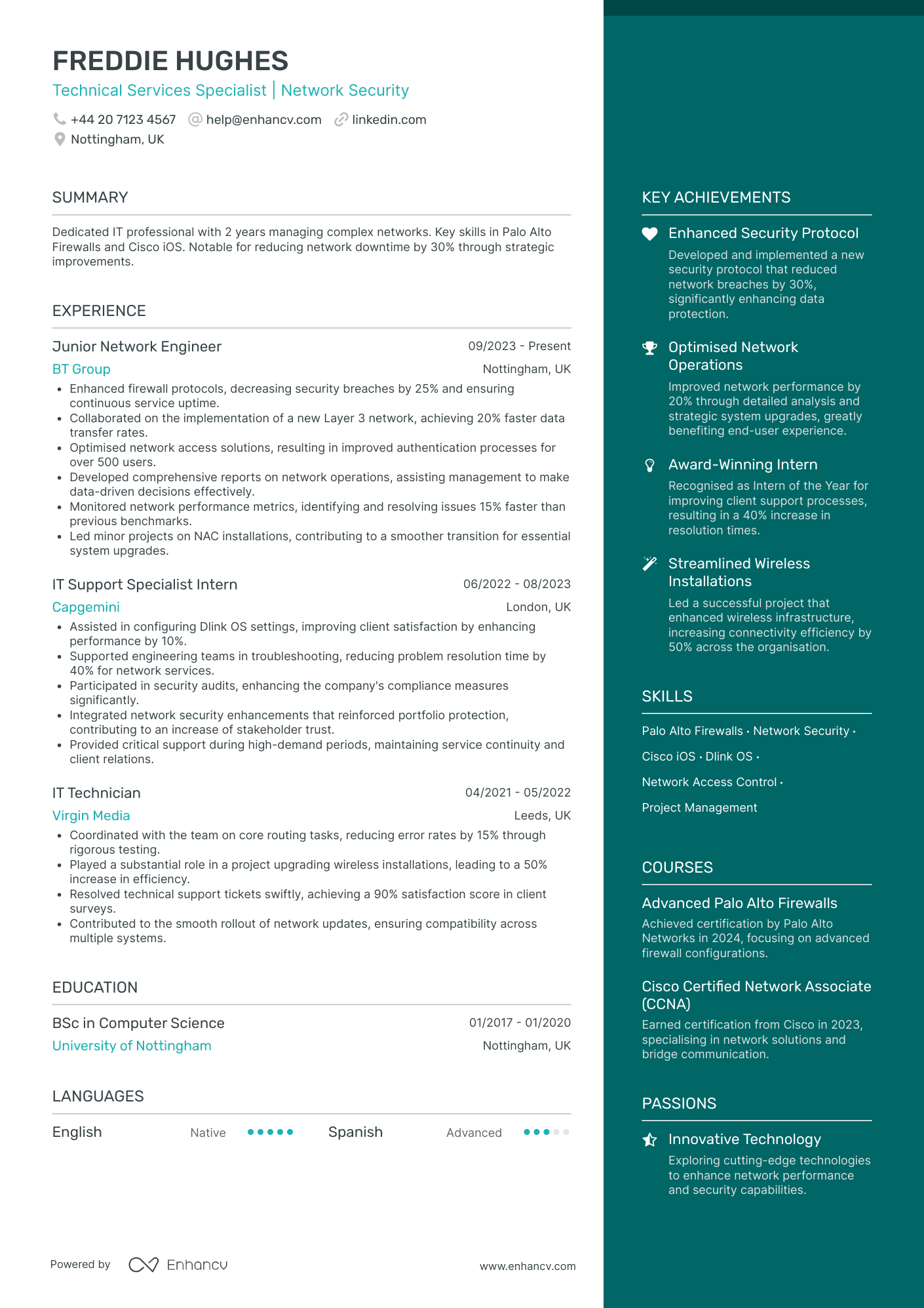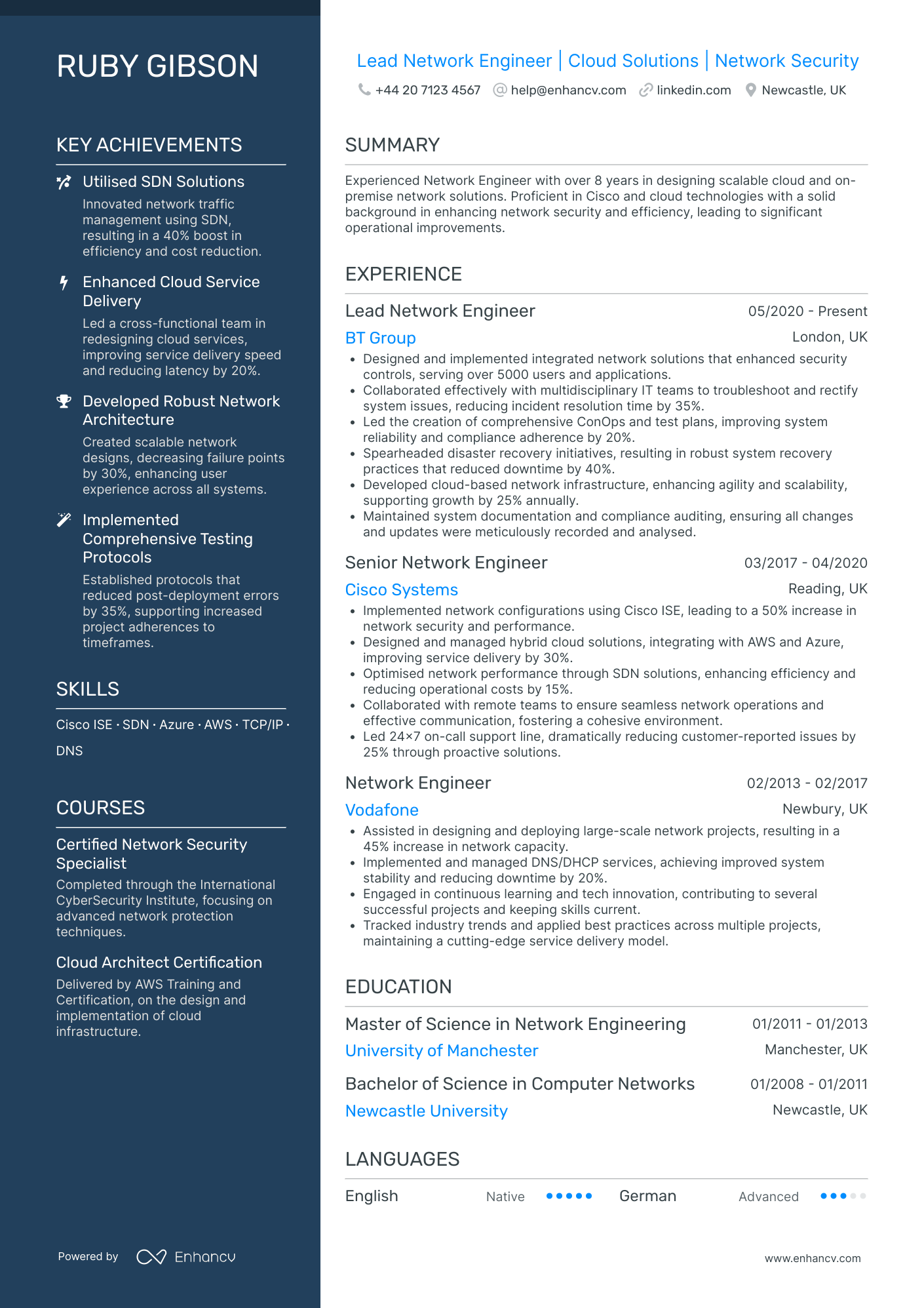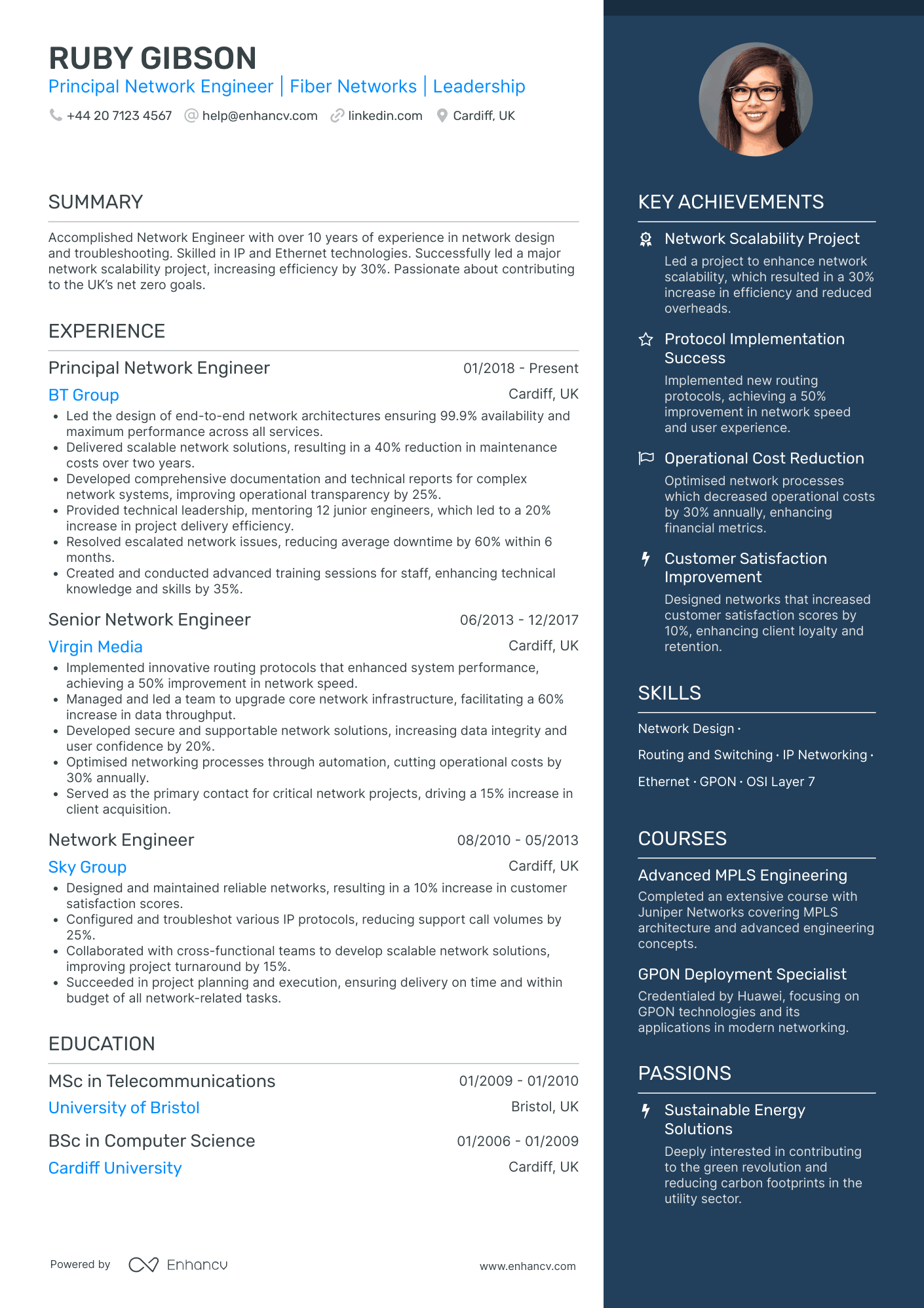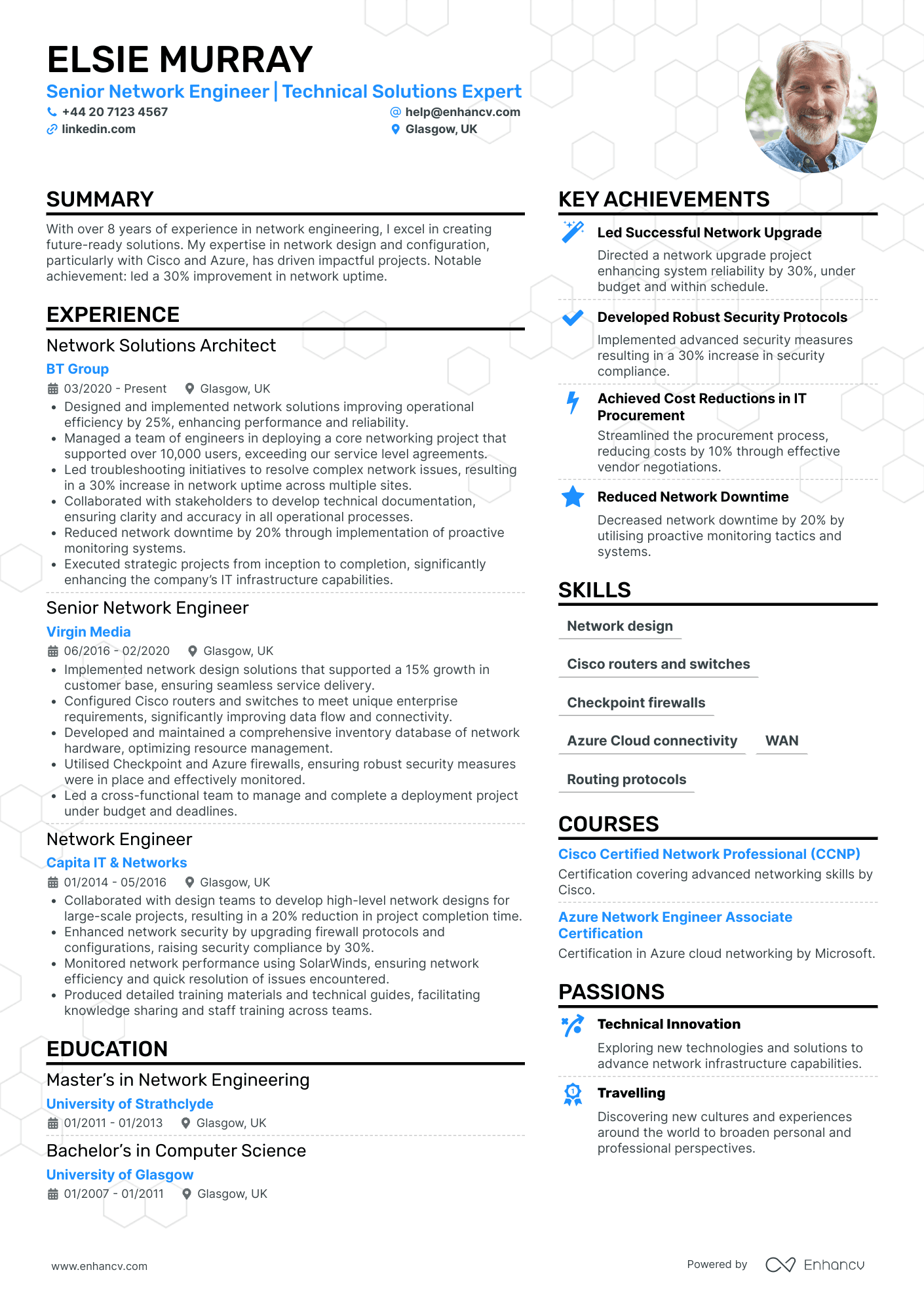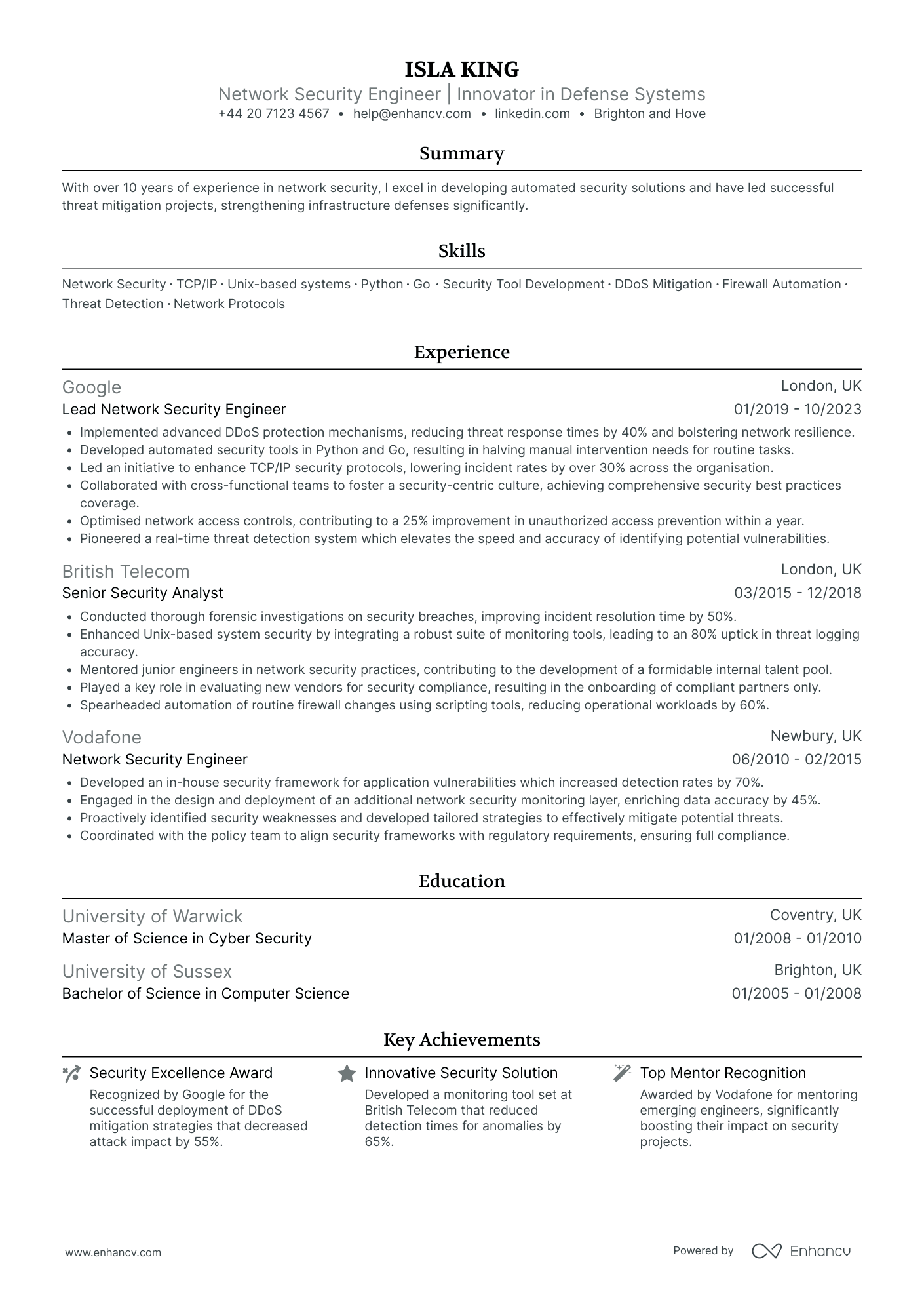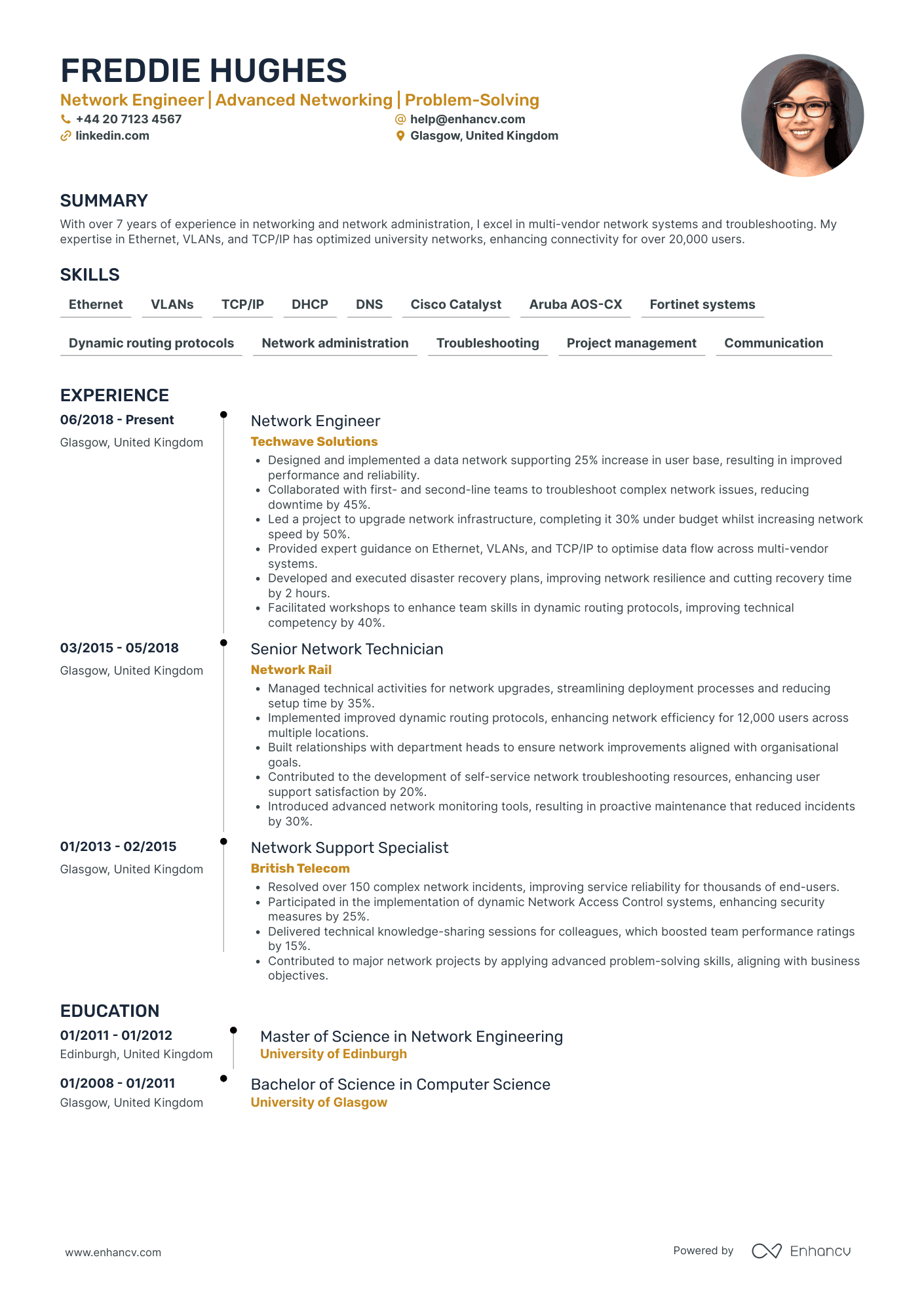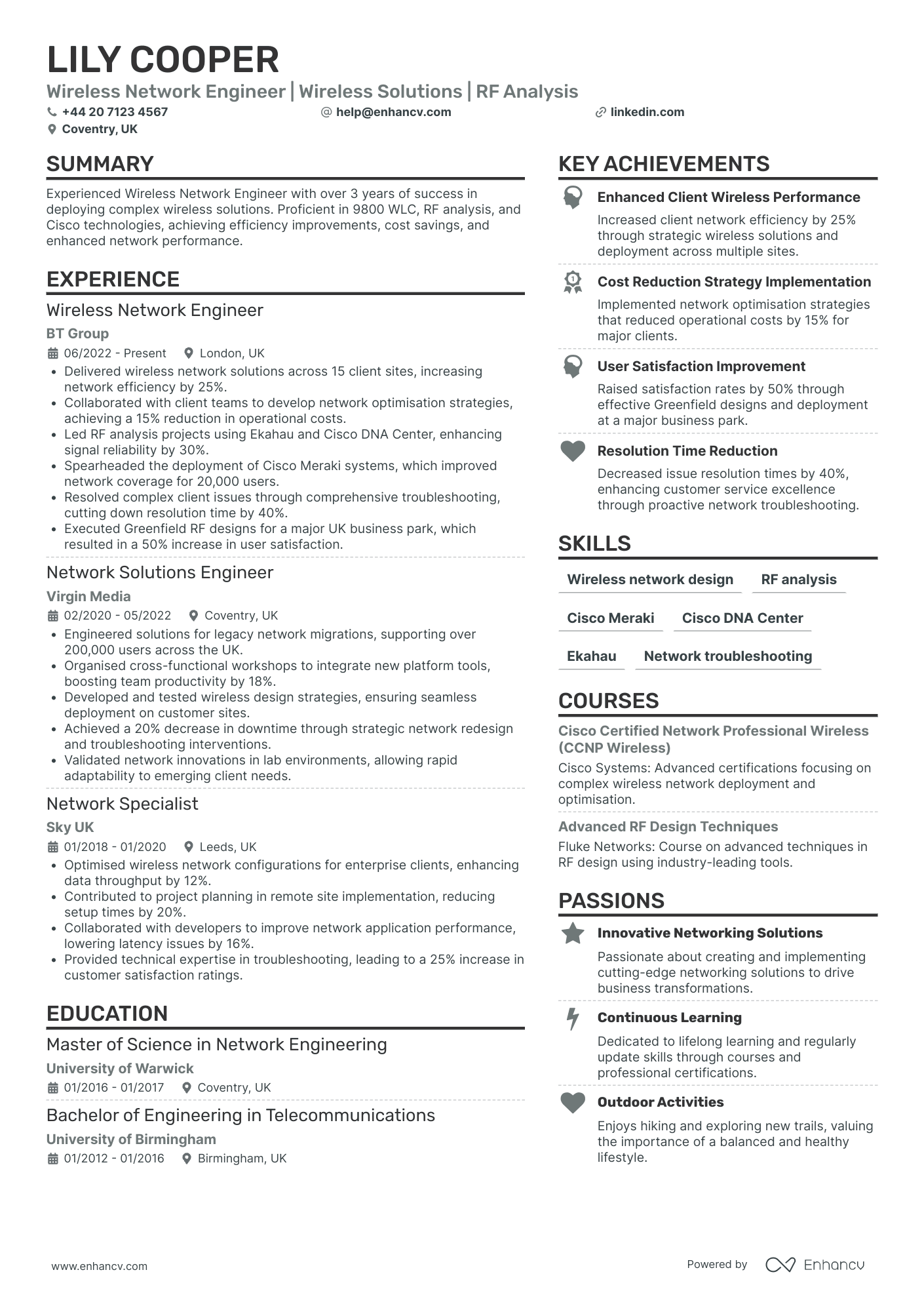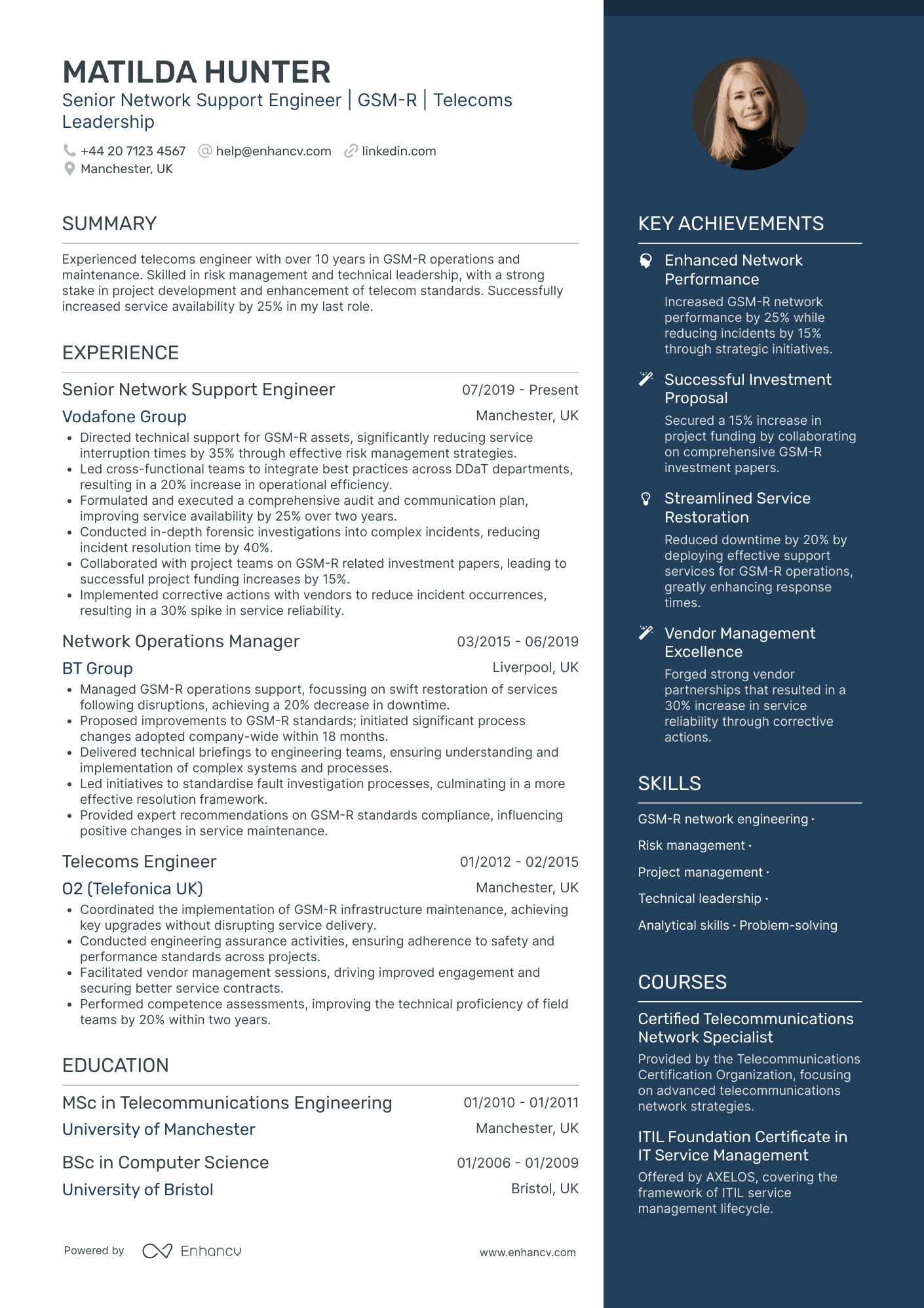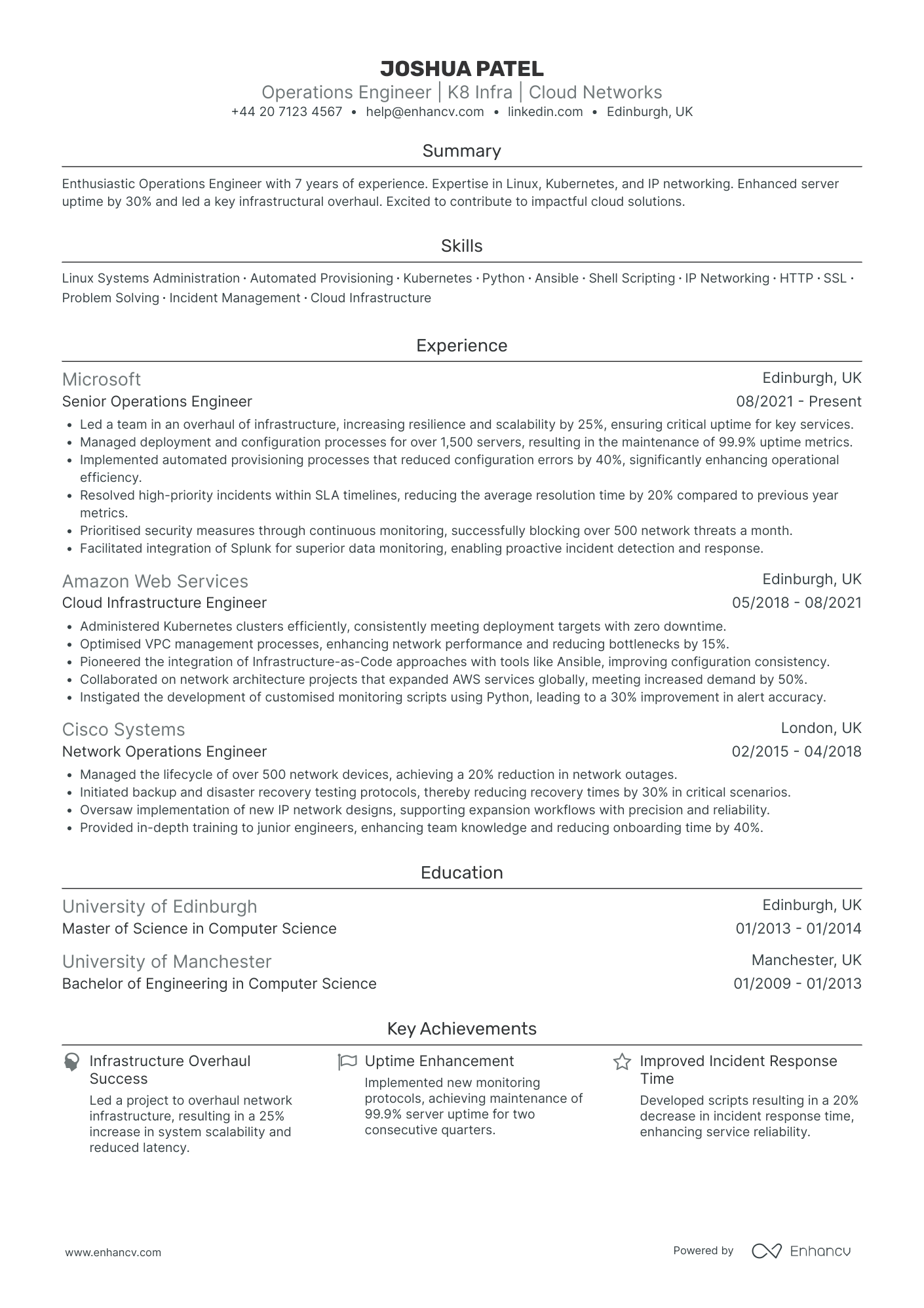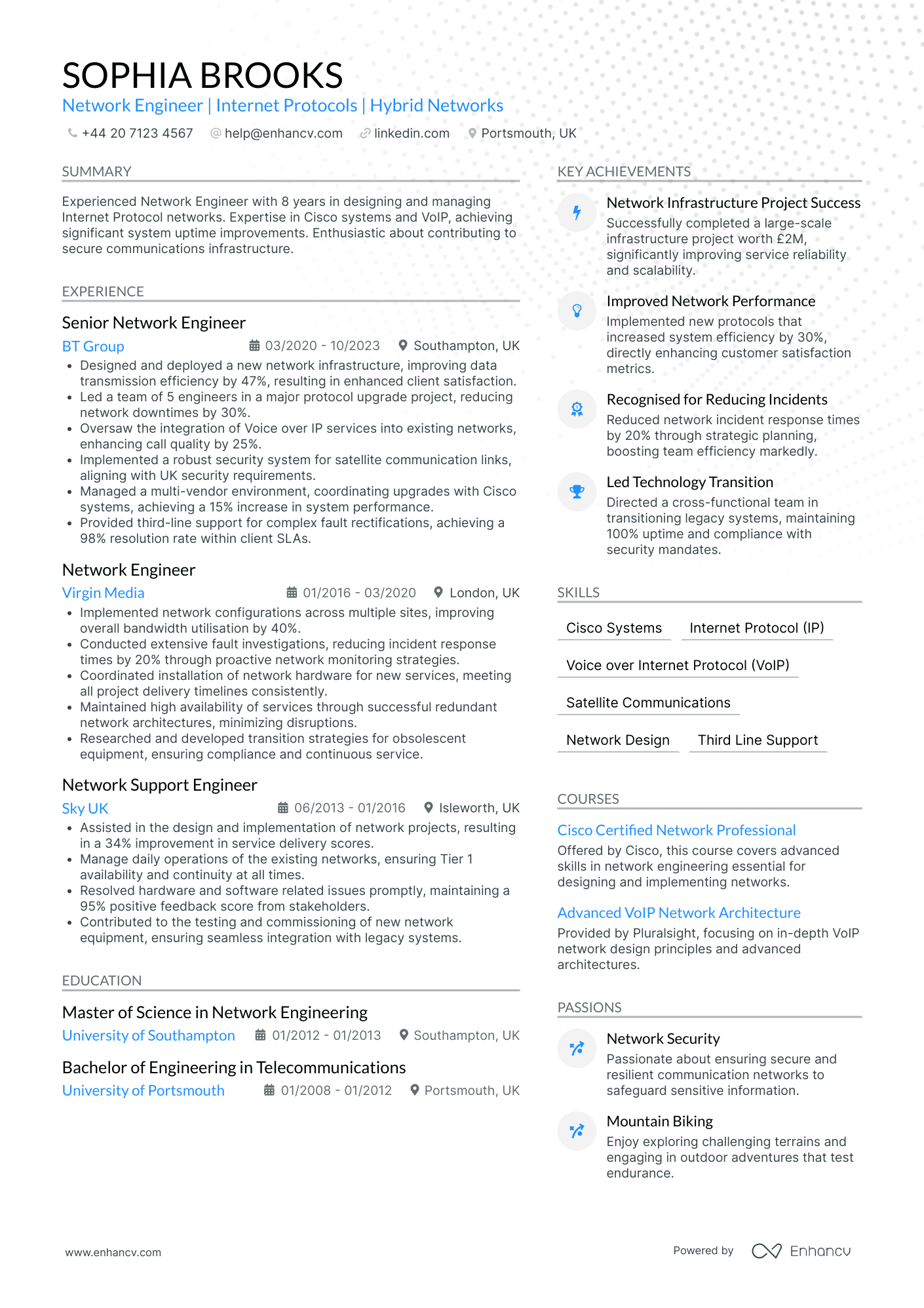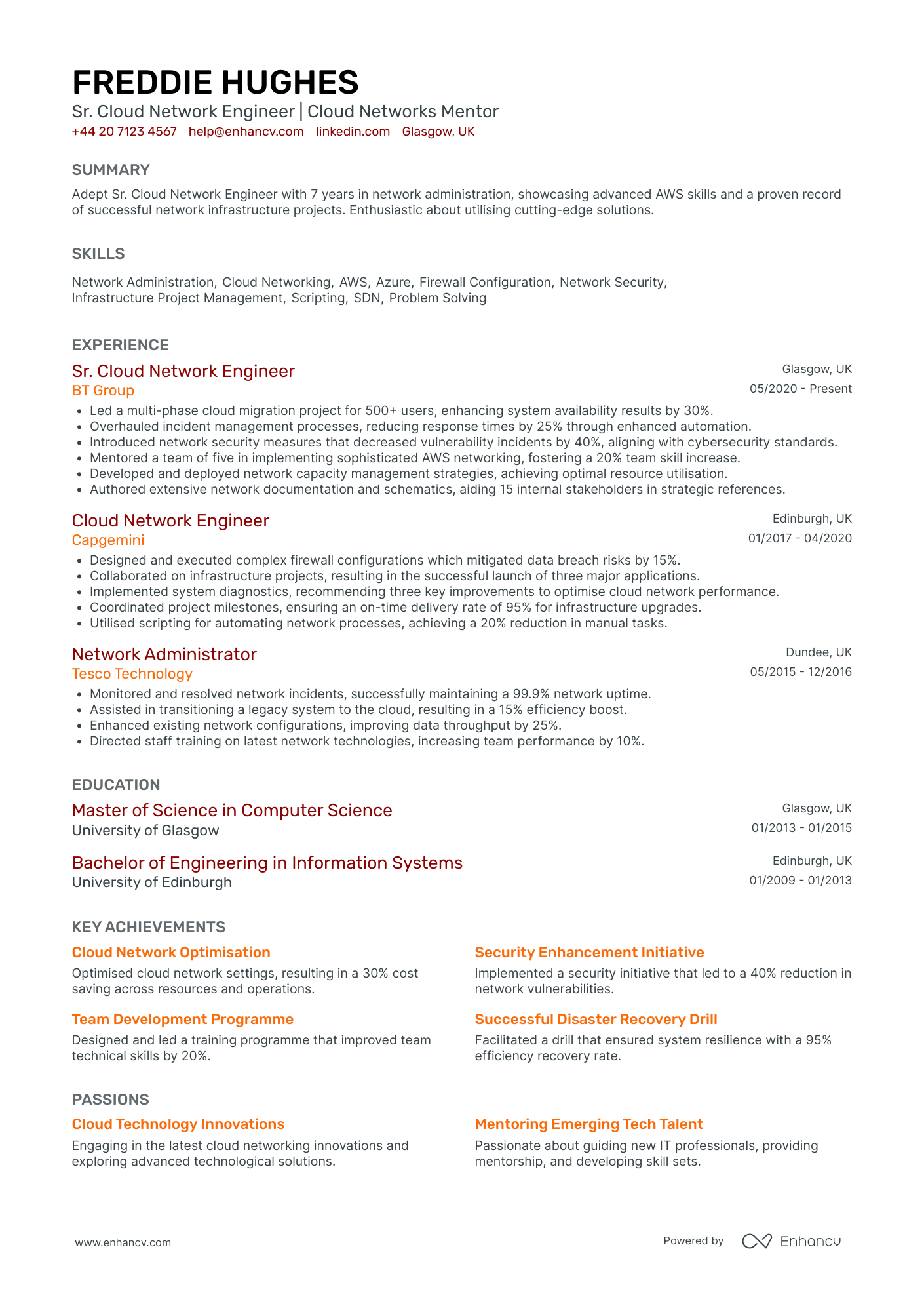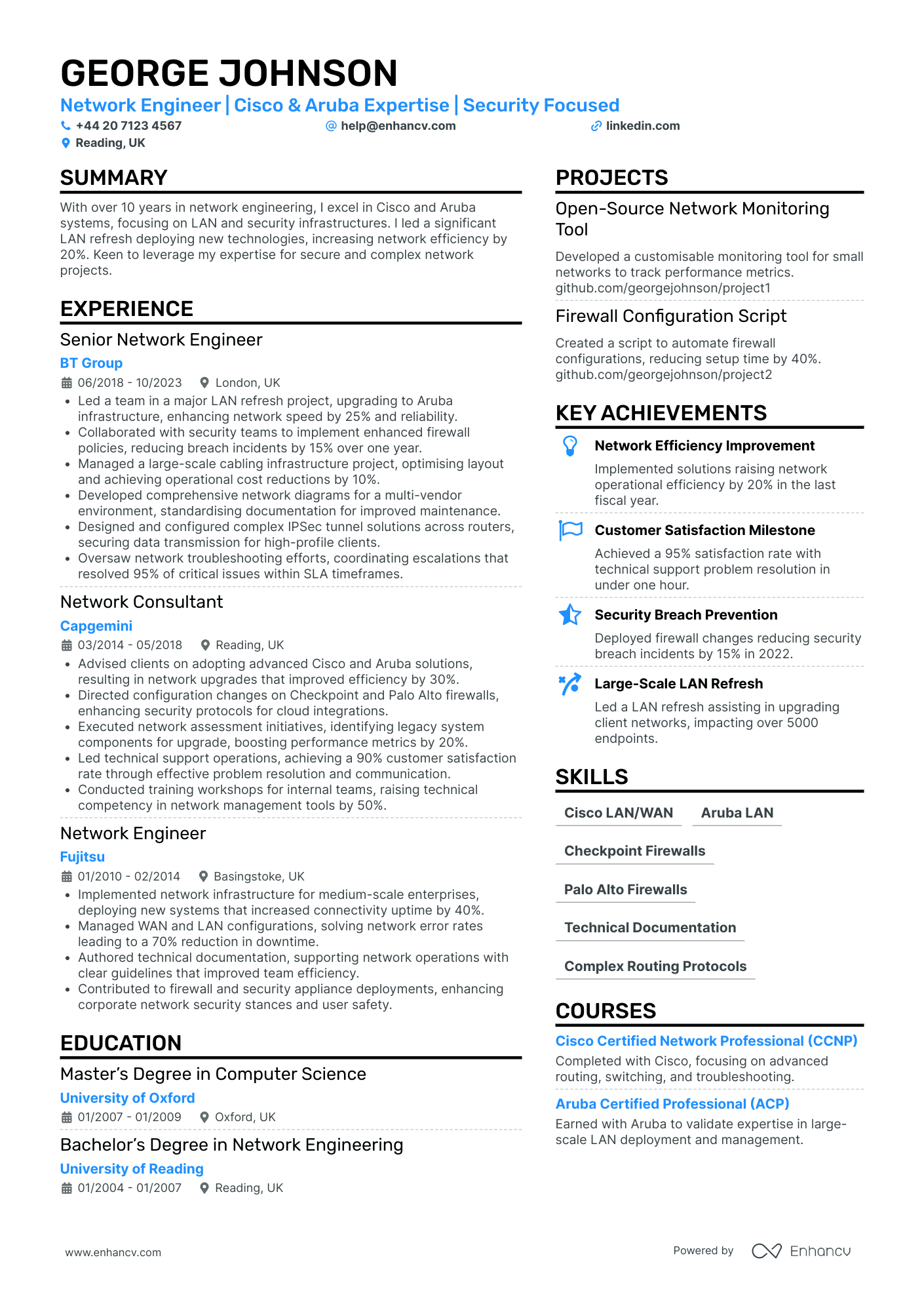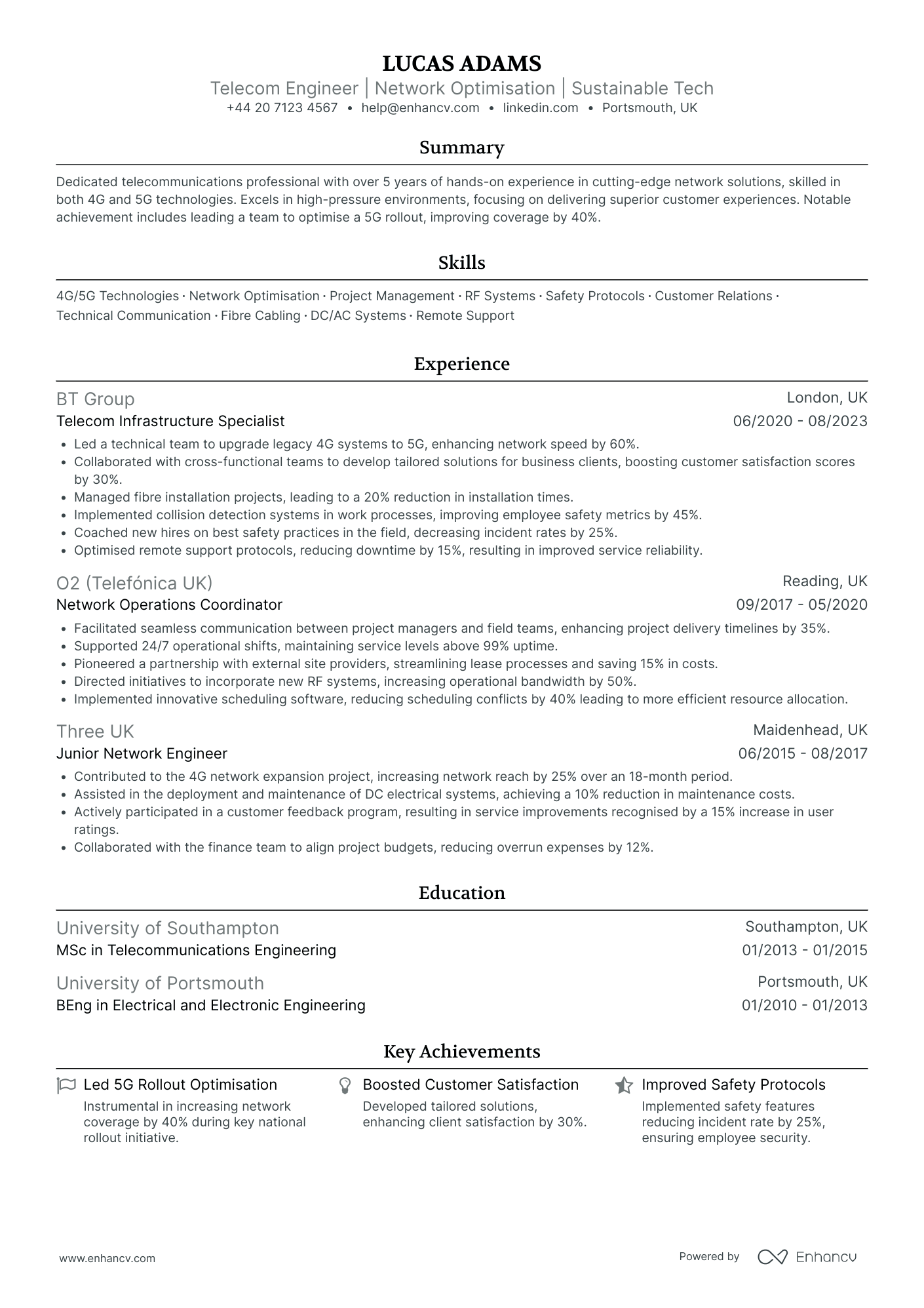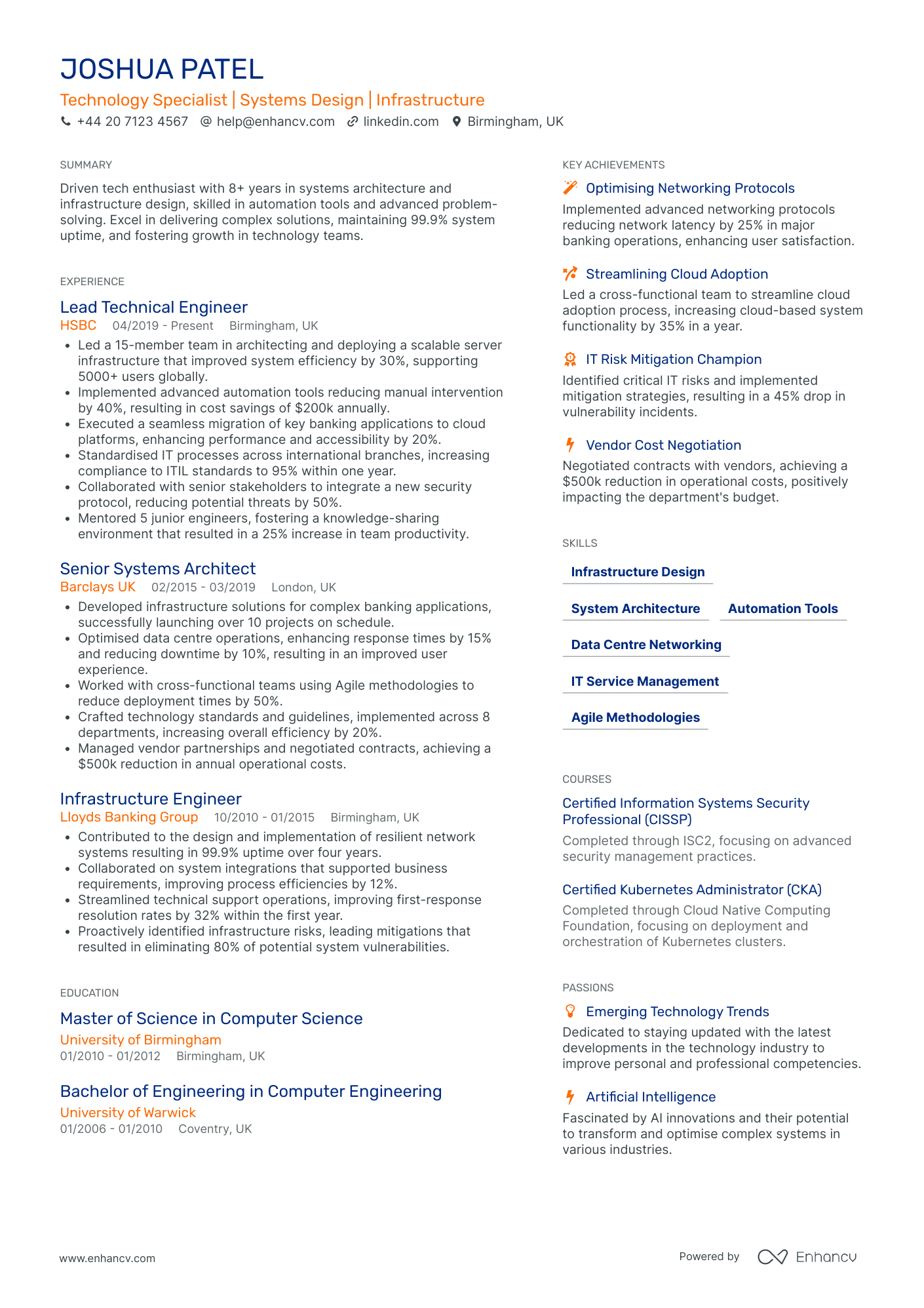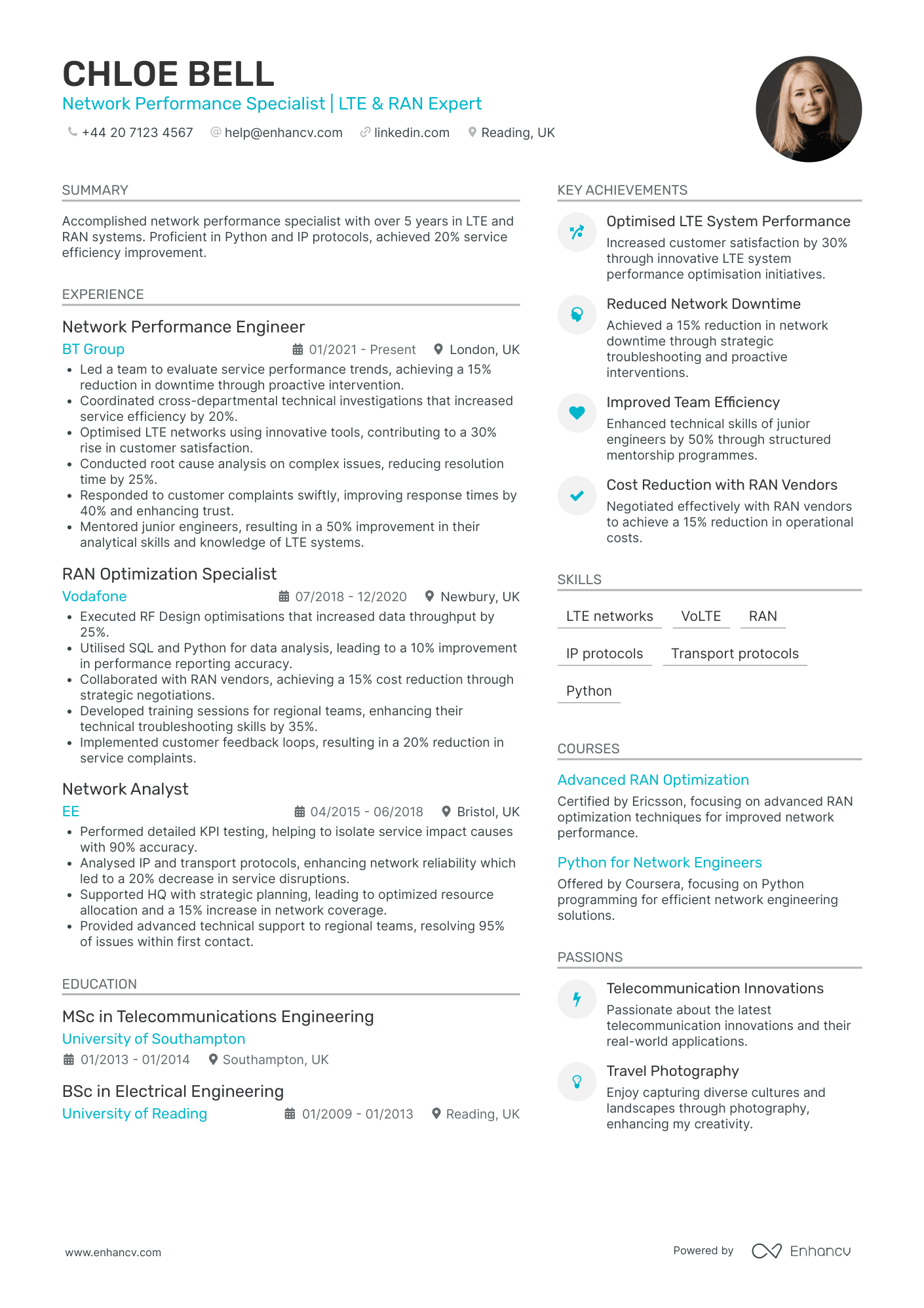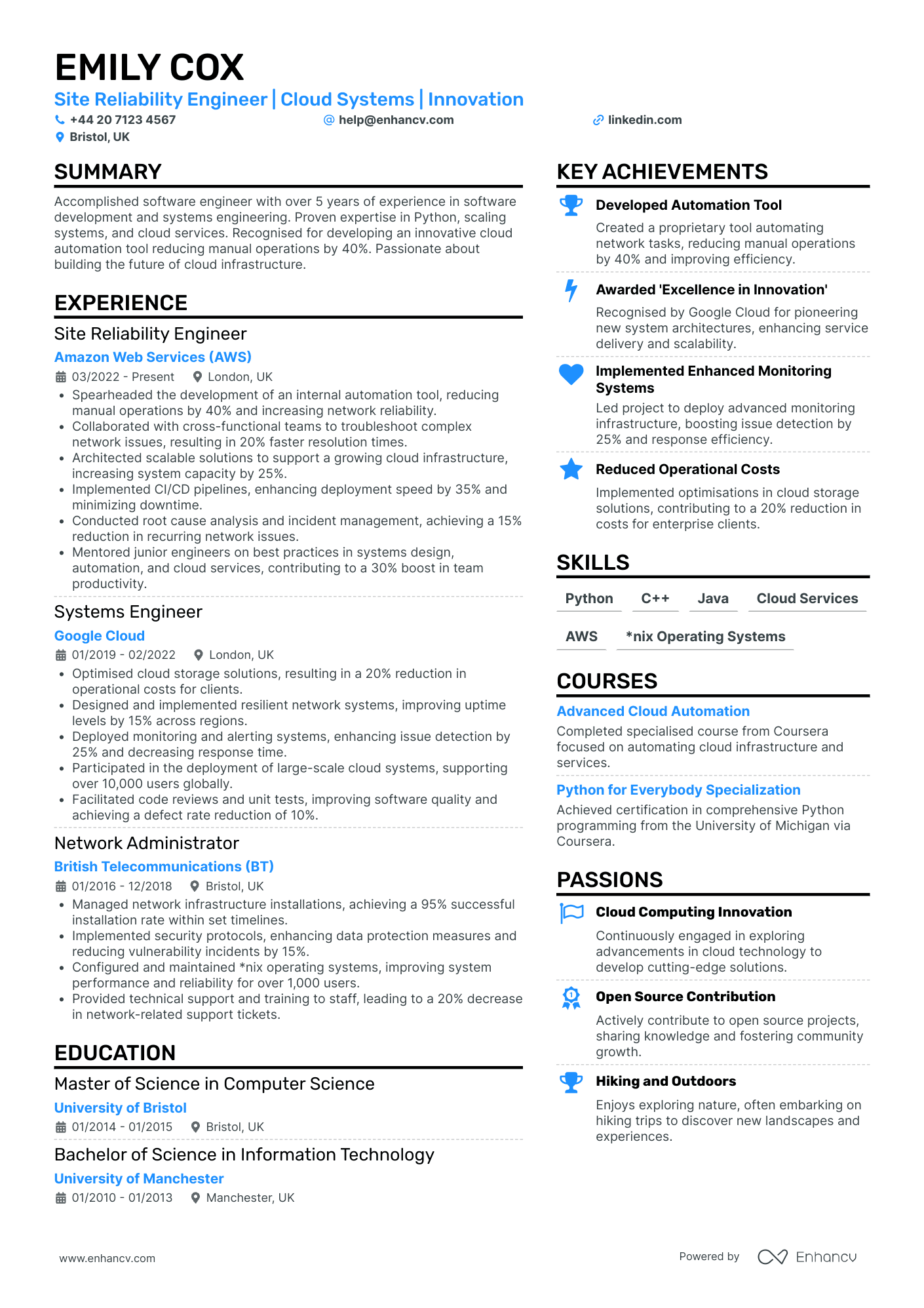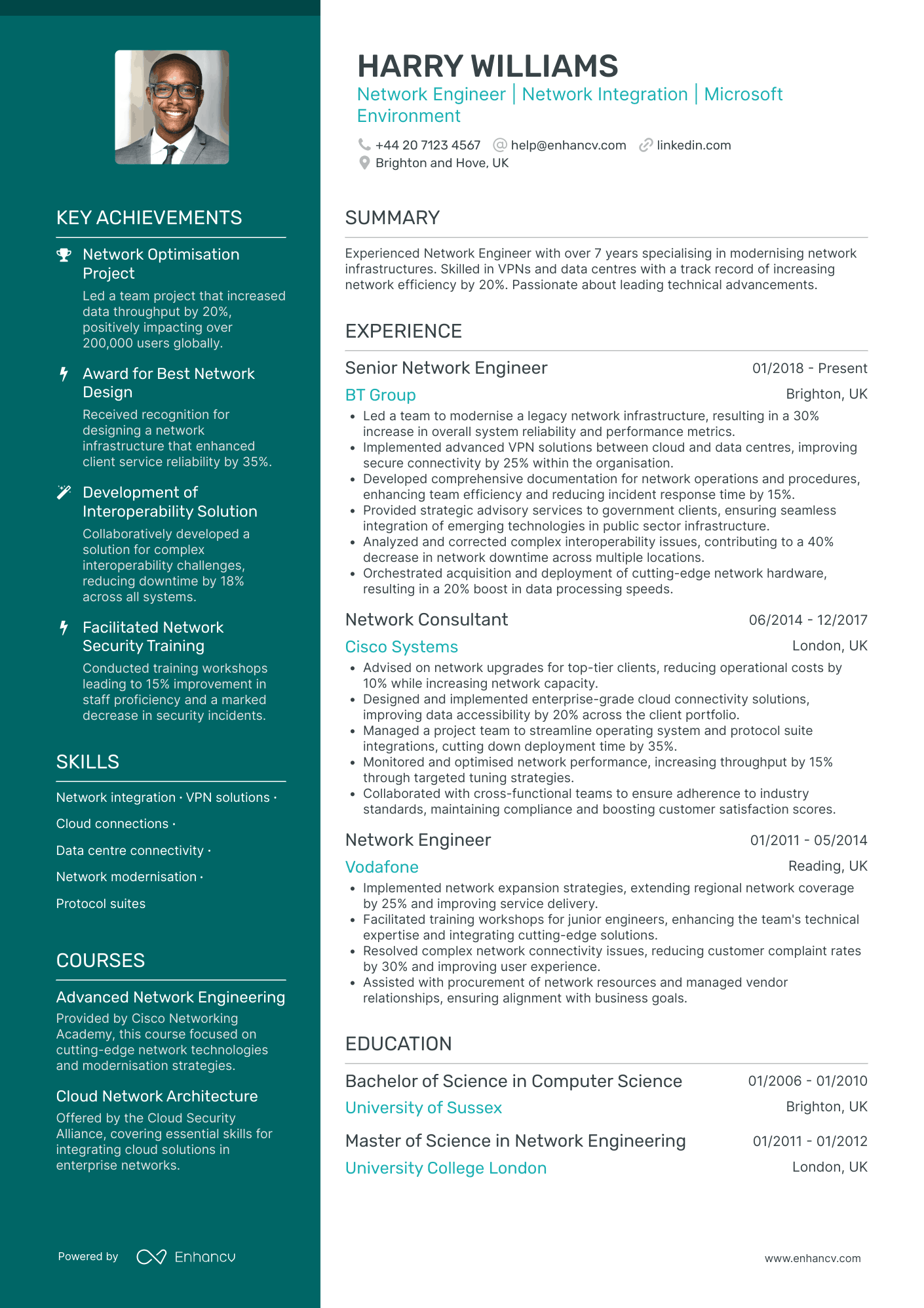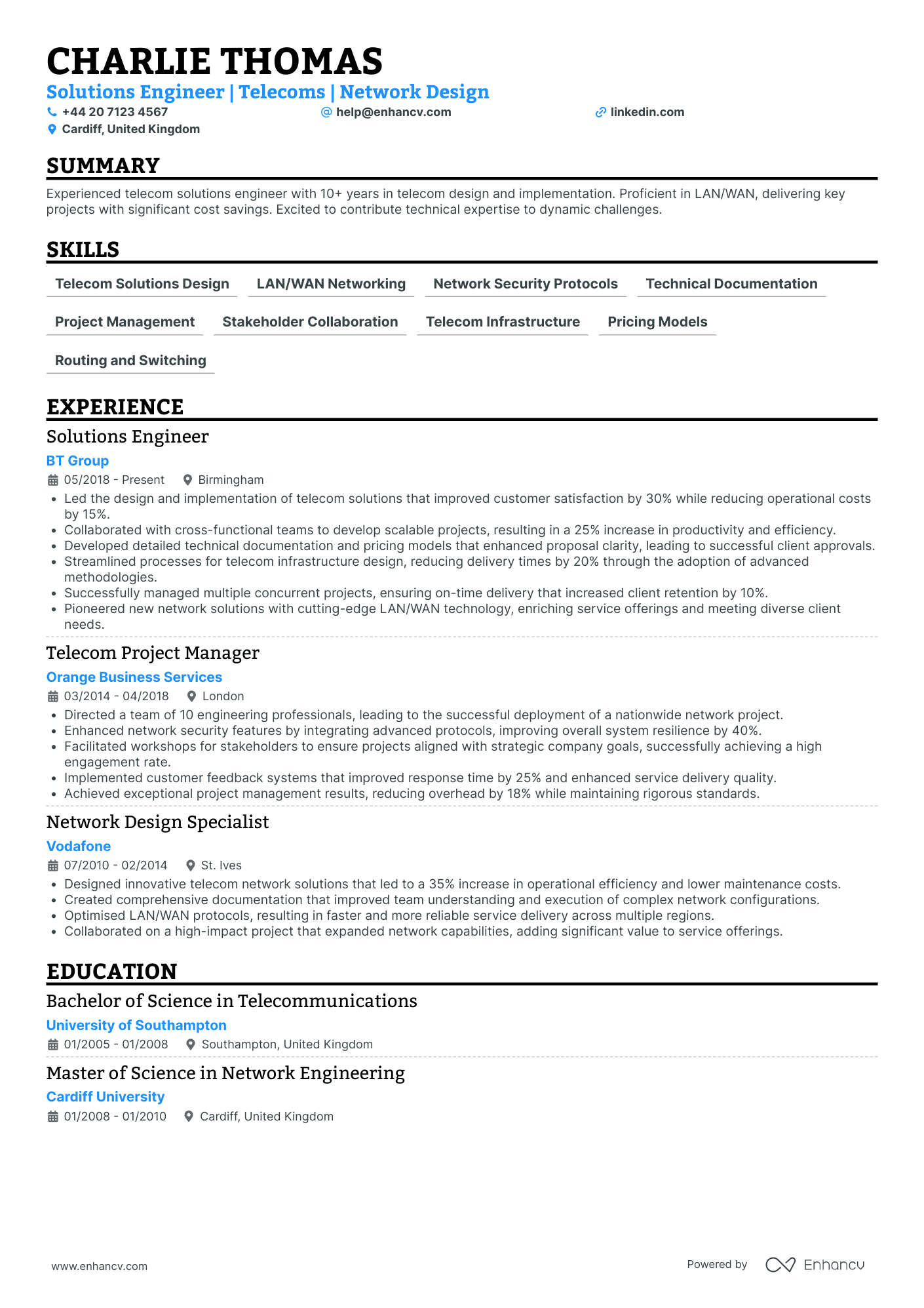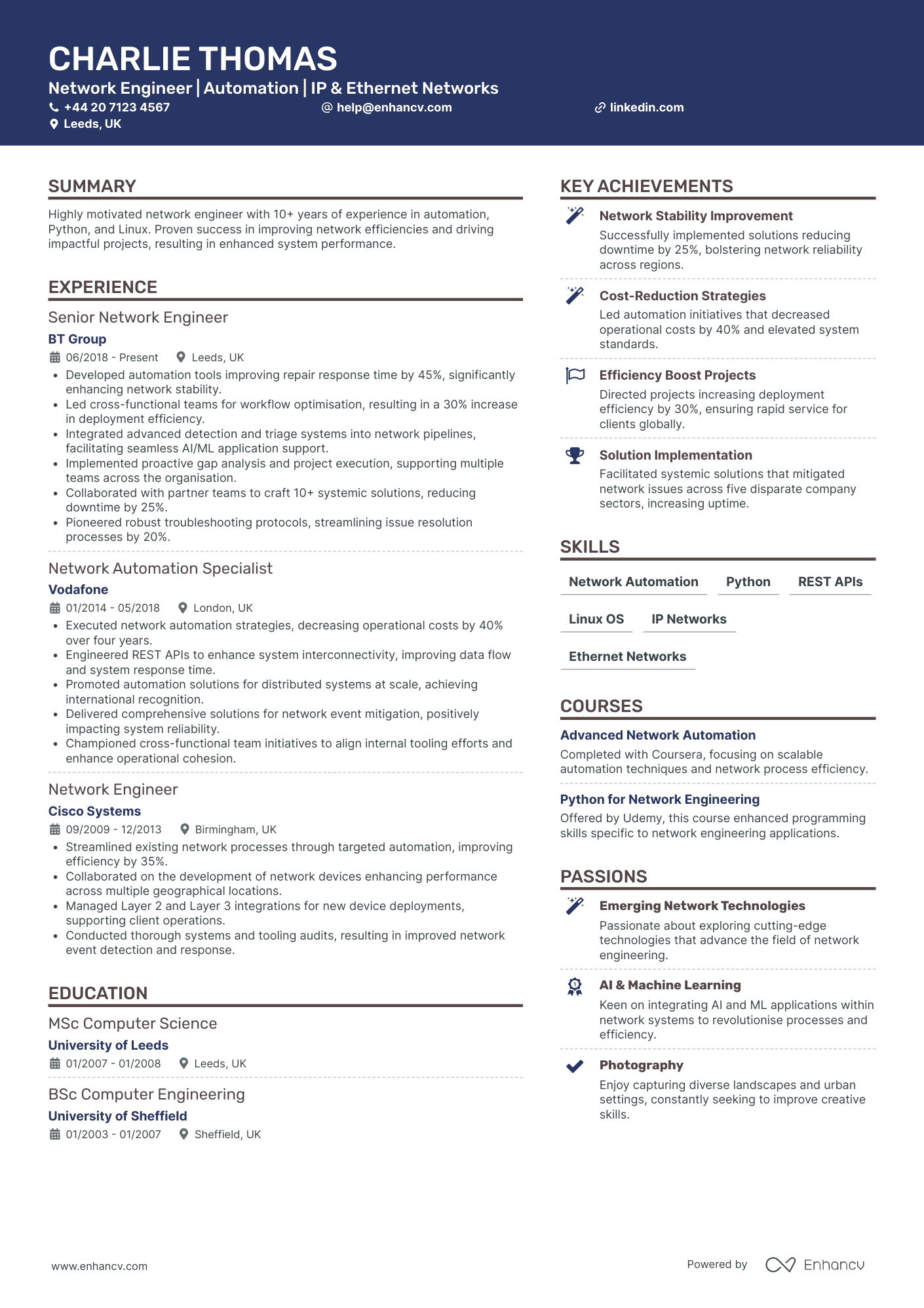Achieving the right balance between technical jargon and accessibility on your CV can be a significant challenge in your quest to showcase your expertise as a network engineer. Our guide offers you tailored advice to fine-tune your language, ensuring it strikes the perfect note with recruiters and highlights your proficiency.
- Answer job requirements with your network engineer CV and experience;
- Curate your academic background and certificates, following industry-leading CV examples;
- Select from +10 niche skills to match the ideal candidate profile
- Write a more succinct experience section that consists of all the right details.
Do you need more specific insights into writing your network engineer CV? Our guides focus on unique insights for each individual role:
CV examples for network engineer
By Experience
Junior Network Engineer
- Logical Career Progression - Freddie Hughes's CV demonstrates a clear and logical career trajectory, beginning as an IT Technician and advancing to his current role as a Technical Services Specialist. Each position builds upon the last, showcasing his growth in skills and responsibilities, particularly within network security and technical services.
- Technical Expertise and Specialization - The CV highlights Freddie's proficiency with industry-specific tools and technologies like Palo Alto Firewalls and Cisco iOS, illustrating a deep technical understanding crucial for network security roles. His courses and certifications further attest to his specialization and ongoing commitment to staying updated in his field.
- Impactful Achievements - Freddie's achievements are not only quantified but also contextualized in terms of business impact. For instance, his work on reducing network breaches by 30% directly links to increased data protection, showcasing his ability to contribute meaningfully to organizational goals while aligning with business priorities.
Lead Network Engineer
- Comprehensive and Structured Presentation - The CV is well-structured with clear sections that guide the reader through Ruby Gibson's professional journey. Each section, from experience and education to skills and languages, is concise yet informative, allowing easy navigation and quick comprehension of key points.
- Demonstrated Career Progression and Growth - Ruby Gibson's career trajectory shows significant growth, moving from a Network Engineer to a Lead Network Engineer. This progression highlights her increasing responsibilities and expertise in cloud solutions and network security, illustrating her commitment and ability to evolve in the technology sector.
- Industry-Specific Tools and Methodologies - The CV effectively showcases Ruby's proficiency in industry-specific tools and methodologies, such as Cisco ISE, SDN solutions, and cloud platforms like AWS and Azure. This technical depth emphasizes her capability to leverage innovative solutions for network optimization and security enhancement.
Principal Network Engineer
- Structured Career Growth - Ruby's career trajectory is prominently illustrated through successive roles of increasing responsibility, from a Network Engineer at Sky Group to a Principal Network Engineer at BT Group. This progression underscores her ability to take on leadership roles and manage increasingly complex projects, exemplifying her growth and adaptability in the rapidly evolving telecommunications sector.
- Technical Proficiency and Methodologies - The CV showcases a command over a wide array of networking tools and technologies, including GPON, MPLS, BGP, and Ethernet. Ruby has also undertaken specialized training, such as the Advanced MPLS Engineering course, highlighting her dedication to technical excellence and her desire to maintain industry-relevant skills.
- Impactful Achievements - Ruby’s achievements are explicitly linked to business outcomes, such as reducing maintenance costs by 40% and increasing network speed by 50% through innovative routing protocols. These accomplishments not only reflect technical acumen but also her strategic mindset in improving operational efficiencies and enhancing the customer experience.
By Role
Senior Network Engineer
- Clarity in Content Presentation - The CV stands out with its clear and logically structured sections that make the content easily digestible. By using headings and bullet points, it allows quick scanning and ensures that each pivotal moment in the career is highlighted without overwhelming the reader. This focused presentation aids in creating an immediate understanding of the candidate's qualifications and experience.
- Progressive Career Trajectory - The career history underscores significant professional advancements, detailing a path of consistent growth through roles and responsibilities. It illustrates a journey from entry-level positions to leadership roles, accentuating a record of promotions and increased responsibilities within the same organization. This trajectory gives a strong impression of reliability and competence, implying the candidate’s capability to contribute progressively within the industry.
- Integration of Soft Skills and Leadership - In addition to technical capabilities, the CV showcases a commitment to leadership and team management through tangible examples. Highlighting successful mentorship programs and cross-departmental collaborations, it poises the candidate as not just technically adept but also as a leader who fosters an inclusive and motivated environment, crucial for driving team success.
Network Security Engineer
- Clear and Structured Presentation - The CV is presented in a structured and concise manner, ensuring clarity and ease of readability. Key elements such as professional experience, education, skills, and achievements are distinctly organized, enhancing the presentation's impact and allowing employers to quickly gauge the applicant's suitability.
- Robust Career Trajectory - Isla King's career path demonstrates significant growth within the realm of network security, progressing from a Network Security Engineer at Vodafone to a Lead Network Security Engineer at Google. This progression highlights both expertise and the ability to rise within competitive environments, showcasing leadership development alongside technical advancement.
- Impactful Achievements with Business Relevance - The CV details tangible achievements in a way that goes beyond mere figures, illustrating business impacts. For instance, the reduction of threat response times by 40% at Google and enhancing incident resolution time by 50% at British Telecom are not only numerical successes but also reflect substantial contributions to organizational resilience and operational efficiency.
Network Systems Engineer
- Effective Content Presentation - The CV is structured in a way that enhances readability, with clear headings and bullet points that concisely outline major accomplishments and responsibilities. The use of distinct sections allows for easy navigation, making it effortless for recruiters to identify key information quickly, which is crucial in high-paced recruitment environments.
- Career Progression and Growth - A significant upward trajectory is evident, with the candidate steadily advancing from junior roles to senior positions. This progression is marked by promotions and increased responsibilities, which highlight the candidate's ability to excel and adapt within their industry. The journey from an entry-level position to a management role demonstrates a commitment to professional development and leadership.
- Unique Industry-Specific Tools and Methodologies - The CV distinguishes itself through detailed mention of niche tools and advanced methodologies relevant to the candidate’s field. It showcases familiarity with essential industry software like Tableau and MATLAB, along with innovative techniques in data analysis. Such technical depth underscores the candidate's strong capability and readiness to deliver specialized solutions within their sector.
Wireless Network Engineer
- Clear Structure and Conciseness - The CV is structured to provide a crisp and organized overview of Lily Cooper's qualifications and experiences. It uses headings and bullet points effectively, allowing the reader to easily navigate through different sections such as experience, education, and achievements. This clarity ensures that key details stand out without overwhelming the reader.
- Impressive Career Trajectory - Lily's career shows significant growth and specialization in the field of wireless networking. Moving from a Network Specialist at Sky UK to a Wireless Network Engineer at BT Group demonstrates a clear upward trajectory and increasing levels of responsibility, signifying her capability to manage complex projects and lead technological advancements in the wireless solutions industry.
- Technical Proficiency with Industry Tools - The CV showcases specific expertise in advanced industry tools and methodologies such as Cisco DNA Center, Ekahau, and Cisco Meraki. Her proficiency with these technologies highlights Lily's technical depth and her ability to leverage cutting-edge tools to enhance network performance and reliability, which is crucial in her field.
Network Support Engineer
- Structured and Concise Presentation - The CV effectively organizes information with clear headers and bullet points, making it easy to navigate through Matilda Hunter’s extensive career. The summary succinctly conveys her experience and impact, while each section is cleanly divided to maintain clarity and focus. This structure ensures that key achievements and skills stand out for quick assessment.
- Diverse Career Trajectory with Notable Growth - Matilda's career progression from a Telecoms Engineer to a Senior Network Support Engineer highlights her growth and increasing responsibility in GSM-R operations. This trajectory not only points to her capability but also her adaptability in taking on leadership roles, evident in her experience at major companies like Vodafone and BT Group.
- In-depth Technical Expertise in Telecom Networks - The inclusion of specific industry methodologies, such as GSM-R network engineering and ITIL service management, underscores Matilda's technical proficiency. Her ability to spearhead initiatives that enhance telecom standards and increase service reliability is a distinctive element that sets her apart in her field.
Network Operations Engineer
- Structured Presentation and Clarity - The CV is structured logically, starting with a succinct summary that sets the tone for the rest of the document. Bullet points under each job role provide clear, specific duties and achievements, making it easy for employers to understand the candidate's contributions quickly. This clarity and segmentation enable easier digestion of the technical skills and achievements listed.
- Diverse Technical Skills and Depth - Joshua's CV highlights an extensive range of technical expertise, particularly with advanced tools like Kubernetes and Ansible. His comfort with Infrastructure-as-Code and network provisioning showcases deep industry-specific knowledge, which is essential for an operations engineer role. These aspects demonstrate his ability to leverage sophisticated technologies for operational enhancements effectively.
- Proactive Leadership and Problem-Solving Skills - Beyond his technical acumen, Joshua’s CV emphasizes his leadership qualities and problem-solving capabilities. He led significant projects, mentored junior engineers, and implemented enhancements that led to tangible improvements in uptime and threat mitigation. These examples illustrate his proactive approach to leadership and his ability to foster team development within high-stakes environments.
Telecom Network Engineer
- Structured Presentation - The CV is structured to guide the reader through a logical progression of the candidate’s career, education, and skills. It ensures clarity by presenting experience in a reverse chronological order and grouping all technical certifications and courses under one section, avoiding fragmentation. This conciseness is ideal for recruiters to quickly grasp the scope and depth of the candidate's abilities.
- Demonstrated Leadership and Team Management - Sophia's career trajectory reveals not just technical proficiency but also significant leadership growth. Her move to a Senior Network Engineer role at BT Group involved leading a team of engineers, indicating her ability to drive projects and inspire others towards achieving organizational goals. This highlights her well-rounded soft skills essential for higher-level positions.
- Impactful Achievements with Business Relevance - The achievements section succinctly communicates Sophia's contributions to the organizations she worked with, moving beyond mere numbers. For instance, completing a £2M infrastructure project and leading a technology transition with a focus on compliance and uptime underscores her ability to undertake projects that enhance service reliability and company sustainability, which are critical factors for a network engineer role.
Cloud Network Engineer
- Strategic Leadership and Mentoring - Freddie Hughes showcases strong leadership abilities through successful management of cloud migration projects and mentoring a team of five. His role includes enhancing team skills by 20% through personalized mentorship and leading strategic initiatives that align with company goals, such as improved network security measures.
- Technical Proficiency in Cloud Networking - The CV highlights Freddie’s advanced AWS skills and command over cloud networking, which are essential for his role. He also has a proven track record with tools and technologies, which include designing complex firewall configurations and optimizing infrastructure projects, further demonstrating his technical depth.
- Implementation of Cost-effective Solutions - Business impact is significant in Freddie's accomplishments, such as reducing network vulnerability incidents by 40% and optimizing cloud network settings for a 30% cost saving. His achievements display an ability to derive cost-effective solutions while maintaining high performance and security standards.
Network Software Engineer
- Clear Structure and Concise Presentation - The CV is structured clearly, allowing easy navigation through sections such as experience, education, and skills. The use of bullet points keeps the information concise, ensuring that key achievements and responsibilities are highlighted effectively without overwhelming the reader.
- Comprehensive Career Growth - George's career trajectory shows progressive development, from his initial role as a Network Engineer at Fujitsu to his current senior position at BT Group. This upward mobility reflects both expertise and adaptability in complex networking roles, emphasizing his continued advancement and significant contributions to the sector.
- Technological and Methodological Expertise - The CV outlines unique industry-specific elements such as proficiency in Cisco and Aruba technologies, as well as expertise in advanced firewall configurations with Checkpoint and Palo Alto. These technical skills are further complemented by his experience in implementing IPSec tunnels and developing complex network diagrams, showcasing deep technical acumen and problem-solving capabilities.
Network Field Engineer
- Structured Clarity and Conciseness - The CV effectively organizes roles and experiences in a clear, logical structure, using concise bullet points that allow quick absorption of the candidate's qualifications and accomplishments, ensuring no detail is overlooked by potential employers.
- Career Trajectory with Measured Growth - The progression from Junior Network Engineer to Telecom Infrastructure Specialist illustrates significant career growth within the telecommunications industry while highlighting increased responsibilities and leadership roles, culminating in initiatives that greatly enhanced network efficiencies.
- Technical Depth in Industry-Specific Tools and Methodologies - The CV distinguishes itself with detailed references to industry-specific technologies such as 4G/5G systems, RF systems, and fibre optic installations, showcasing deep technical expertise and up-to-date knowledge in the telecom sector.
Data Centre Network Engineer
- Effective Presentation and Structure - The CV is structured clearly, presenting important information in concise sections that are easy to navigate. It begins with a powerful summary that quickly communicates the candidate's extensive experience and capabilities. The use of bullet points in the experience section provides clarity and makes accomplishments easily scannable, enabling readers to quickly grasp the candidate's achievements and skills.
- Progressive Career Growth - Joshua’s career trajectory shows a steady upward movement in roles and responsibilities, reflecting a pattern of personal and professional development. Transitioning from an Infrastructure Engineer to a Lead Technical Engineer demonstrates a successful climb up the career ladder within the tech industry. Each position held indicates a broadening of scope, such as the shift from technical execution to strategic leadership at HSBC.
- Technical Acumen and Advanced Methodologies - The CV highlights Joshua's deep technical expertise, mentioning the use of industry-specific tools like automation software and Cloud Platforms, and methodologies including ITIL standards and Agile. His certifications in CISSP and CKA add credibility to his proficiency in security and systems administration, showcasing a commitment to maintaining up-to-date knowledge in fast-evolving tech domains.
Network Performance Engineer
- Structured and Focused Presentation - The CV is well-organized into sections that convey relevant information succinctly. Each segment is delineated clearly, ensuring that skills, achievements, and experiences are immediately accessible to the reader. This structure helps maintain attention and enhances understanding of the candidate’s qualifications.
- Progression in Network Engineering - Chloe Bell's career trajectory has demonstrated consistent growth within the telecommunications industry. Starting as a Network Analyst, Chloe has successfully moved into specialized roles such as RAN Optimization Specialist and Network Performance Engineer, reflecting an upward progression and increased responsibility in each position.
- Industry-Specific Proficiency with Technical Tools - Chloe’s CV highlights a deep understanding of specific tools and methodologies essential in the telecommunications field. Proficiency in Python, SQL, and RF Design indicates a technical depth that can greatly enhance network performance, setting Chloe apart as a specialist who not only understands theory but can also implement practical technological solutions.
Network Reliability Engineer
- Emphasizes clear career progression - The CV outlines Emily Cox's growth from a Network Administrator at BT to influential roles in prominent tech companies like Google Cloud and AWS. This progression showcases an upward trajectory in complexity and scale of responsibilities, reflecting her development in the field of systems and cloud engineering.
- Showcases innovation in industry tools and automation - Emily’s expertise in Python and cloud services is underscored by her development of automation tools and scalable solutions. These competencies not only indicate technical proficiency but also her innovative spirit in leveraging technology to enhance operational efficiency and network reliability.
- Highlights adaptability through cross-functional collaboration - Through various roles, Emily has demonstrated adaptability by working across different functions, such as her collaboration with cross-functional teams at AWS. This experience in diverse environments shows her ability to integrate and communicate effectively to solve complex issues.
Network Protocol Engineer
- Consistent career progression showcasing growth - The CV explicitly delineates Harry Williams' upward trajectory from a Network Engineer at Vodafone to a Senior Network Engineer at BT Group. This progression illustrates not only his competence but also his ability to take on increased levels of responsibility, highlighting his professional growth and readiness for leadership roles within the networking domain.
- Emphasis on cross-functional collaboration and adaptability - Throughout his career, Harry has actively collaborated with cross-functional teams, as seen in his roles at both Cisco Systems and BT Group. This experience is crucial in the networking field, where seamless integration and communication with different departments and stakeholders are vital for successful deployment and support of network solutions.
- Impactful achievements demonstrating business relevance - Harry Williams' CV details specific projects with measurable outcomes, such as reducing network downtime by 40% and increasing data throughput by 20%. These achievements reflect a direct positive impact on both operational efficiency and customer satisfaction, underscoring his ability to contribute meaningfully to business goals.
Network Solutions Engineer
- Clarity and Structured Presentation - The CV is presented in a coherent and structured manner, making it easy to navigate through sections such as summary, experience, education, skills, and achievements. Each section is clearly defined, allowing the reader to quickly identify key information about Charlie Thomas's background and qualifications.
- Progressive Career Path - Charlie's career trajectory is a testament to growth and development within the telecom industry. Beginning as a Network Design Specialist and advancing to the roles of Telecom Project Manager and Solutions Engineer, the CV reflects a clear pattern of upward mobility and increasing responsibility, signaling career advancement and expertise.
- Industry-Specific Innovations - The CV highlights Charlie's engagement with cutting-edge LAN/WAN technologies and process optimizations that enhance operational efficiency and service delivery. Achievements such as pioneering network solutions and implementing cost-effective methodologies demonstrate a deep technical understanding and the ability to innovate within the telecom field.
Network Automation Engineer
- Clear and organized presentation - The CV effectively uses a structured format, making it easy to navigate through different sections such as experience, skills, and education. Each section is concisely detailed, ensuring that important information is readily accessible without overwhelming the reader.
- Progressive career trajectory - Charlie Thomas’s career shows an impressive growth pattern, moving from a Network Engineer role at Cisco to a Senior Network Engineer at BT Group. Each position highlights increasing responsibilities and leadership roles, underscoring continuous professional development within the industry.
- Specialized technical expertise - The CV highlights Thomas's in-depth knowledge of specific tools and methodologies, such as Python, REST APIs, and Linux OS. His expertise in network automation and integration of AI/ML applications positions him as a highly skilled professional in the network engineering domain.
Structuring your network engineer CV layout: four factors to keep in mind
There are plenty of best practices out there for your CV layout and design. At the end of the day, a clear format and concise CV message should be your top priority. Use your CV design to enhance separate sections, bringing them to the forefront of recruiters' attention. At the same time, you can write content that:
- Follows the reverse chronological order in the experience section by first listing your most recent jobs;
- Incorporates your contact information in the header, but do skip out on the CV photo for roles in the UK;
- Is spotlighted in the most important sections of your CV, e.g. the summary or objective, experience, education, etc. to show just how you meet the job requirements;
- Is no longer than two-pages. Often, the one-page format can be optimal for your network engineer CV.
Before submitting your CV, you may wonder whether to export it in Doc or PDF. With the PDF format, your information and layout stay intact. This is quite useful when your CV is assessed by the Applicant Tracker System (or the ATS) . The ATS is a software that scans your profile for all relevant information and can easily understand latest study on the ATS , which looks at your CV columns, design, and so much more.

PRO TIP
For certain fields, consider including infographics or visual elements to represent skills or achievements, but ensure they are simple, professional, and enhance rather than clutter the information.

The top sections on a network engineer CV
- Professional Summary highlights expertise and experience.
- Technical Skills section showcases network technologies knowledge.
- Work Experience details relevant job history and achievements.
- Certifications prove formal qualifications and technical competency.
- Education Background includes degrees relevant to network engineering.

What recruiters value on your CV:
- Highlight your understanding of network infrastructure by detailing your experience with routers, switches, firewalls, and load balancers, focusing on both the design and troubleshooting aspects.
- Showcase certifications like CCNA, CCNP, or CompTIA Network+ to establish credibility and demonstrate your commitment to the professional standards in network engineering.
- Emphasise your hands-on experience with network protocols such as TCP/IP, BGP, OSPF, and EIGRP, and explain how you've applied these protocols in complex network topologies.
- Outline your proficiency in network automation by mentioning the use of scripting languages such as Python and configuration management tools like Ansible, which are becoming increasingly crucial in modern network operations.
- Document any experience with cloud services such as AWS, Azure, or Google Cloud, focusing on projects related to network connectivity, security, and performance within cloud environments.
Recommended reads:
How to present your contact details and job keywords in your network engineer CV header
Located at the top of your network engineer CV, the header presents recruiters with your key personal information, headline, and professional photo. When creating your CV header, include your:
- Contact details - avoid listing your work email or telephone number and, also, email addresses that sound unprofessional (e.g. koolKittyCat$3@gmail.com is definitely a big no);
- Headline - it should be relevant, concise, and specific to the role you're applying for, integrating keywords and action verbs;
- Photo - instead of including a photograph from your family reunion, select one that shows you in a more professional light. It's also good to note that in some countries (e.g. the UK and US), it's best to avoid photos on your CV as they may serve as bias.
What do other industry professionals include in their CV header? Make sure to check out the next bit of your guide to see real-life examples:

Examples of good CV headlines for network engineer:
- Network Engineer | CCNP Certified | Cybersecurity Enthusiast | 5 Years in IT Infrastructure Management
- Senior Network Architect | MPLS Expert | ITIL Foundation | 10+ Years' Progressive Experience
- Junior Network Administrator | LAN/WAN Specialist | Recent CompTIA Network+ Graduate | Passion for Cloud Solutions
- Lead Network Operations Analyst | Cisco Environments | Focus on Scalability | 15 Years in Industry
- Network Solutions Engineer | Virtualisation Pro | CCIE Security | Innovative Connectivity Strategist | 8 Years
- Systems & Network Engineer | Disaster Recovery Planning | AWS Certified | Proven Track Record | 6 Years Experience
Opting between a network engineer CV summary or objective
Within the top one third of your network engineer CV, you have the opportunity to briefly summarise your best achievements or present your professional goals and dreams. Those two functions are met by either the CV summary or the objective.
- The summary is three-to-five sentences long and should narrate your best successes, while answering key requirements for the role. Select up to three skills which you can feature in your summary. Always aim to present what the actual outcomes were of using your particular skill set. The summary is an excellent choice for more experienced professionals.
- The objective is more focused on showcasing your unique value as a candidate and defining your dreams and ambitions. Think about highlighting how this current opportunity would answer your career vision. Also, about how you could help your potential employers grow. The objective matches the needs of less experienced candidates, who need to prove their skill set and, in particular, their soft skills.
Still not sure about how to write your CV opening statement? Use some best industry examples as inspiration:

CV summaries for a network engineer job:
- Accomplished Network Engineer with over 10 years of experience in designing, implementing, and troubleshooting complex networks for large organisations. Expertise in Cisco routers, switches, and firewalls. Successfully reduced network outages by 30% for a Fortune 500 company through strategic enhancements.
- Dedicated IT Professional transitioning into Network Engineering with a strong foundation in software development and system administration, bringing 5 years of tech experience. Proficient in Python and Linux environments, with a commitment to achieving CCNA certification to further enhance network management skills.
- Dynamic Systems Analyst, pivoting to a Network Engineer career, leveraging 6 years of experience with enterprise data systems, SQL database management, and a recent focus on network security protocols. Actively seeking to apply analytical skills to a more focused technical networking role.
- Senior Network Engineer, with 15+ years steering complex network projects, holding multiple Cisco certifications, and proficient in multivendor environments. Recognised for designing a secure and resilient network infrastructure for a leading e-commerce platform that supported a 200% traffic surge.
- Aspiring Network Engineer, eager to build foundational expertise in network design, analysis, and security. Keen to apply academic skills from a Master's in Computer Science and recent CCENT certification to real-world applications and contribute to the development of cutting-edge network solutions.
- Recent graduate in Network Systems with a passion for cybersecurity seeking to apply theoretical knowledge and hands-on experience gained through university labs and a 6-month internship. Aim to develop skills in network automation and management with a focus on protecting digital assets against emerging threats.
Narrating the details of your network engineer CV experience section
Perhaps you've heard it time and time again, but, how you present your experience is what matters the most. Your CV experience section - that details your work history alongside your accomplishments - is the space to spotlight your unqiue expertise and talents. So, avoid solely listing your responsibilities, but instead:
- adverts' keywords and integrate those in your experience section;
- Use your CV to detail how you've been promoted in the past by including experience in the reverse chronological order.
Before you start writing your network engineer CV experience section, dive into some industry-leading examples on how to structure your bullets.

Best practices for your CV's work experience section
- Designed and implemented secure network infrastructures using Cisco, Juniper, and HP equipment to support organisational needs, minimising downtime and maximising performance.
- Configured and maintained network hardware including routers, switches, and firewalls, ensuring robust security and compliance with industry standards.
- Utilised network monitoring tools such as SolarWinds, Nagios, and Wireshark to proactively identify and resolve network issues, reducing the mean time to repair by 30%.
- Developed network documentation and topology maps to provide clear understanding of network designs for cross-functional teams and management.
- Led troubleshooting and problem-solving efforts during network outages, coordinating with vendors and IT teams to restore services swiftly.
- Coordinated with project managers on new site deployments, successfully rolling out network infrastructure in line with project timelines and company standards.
- Implemented network security measures, including VPNs, access control lists (ACLs), and intrusion detection systems (IDS) to safeguard sensitive data.
- Planned and executed network upgrades and migrations without service interruption, using change management protocols to maintain operational stability.
- Collaborated with cyber security teams to conduct network audits and vulnerability assessments, recommending enhancements to fortify network defences.
- Designed and implemented a secure multi-site LAN/WAN environment for a leading financial firm, ensuring high availability and redundancy.
- Successfully led the migration of data centre infrastructure to a hybrid cloud model, cutting operational costs by 20%.
- Coordinated with cross-functional teams to roll out VoIP solutions across 10+ locations, enhancing communication capabilities company-wide.
- Spearheaded the deployment of a Cisco-based network infrastructure, resulting in a 30% increase in network performance.
- Developed comprehensive network security policies, and conducted training for 100+ staff members on cybersecurity best practices.
- Optimised network configurations that allowed for a seamless introduction of BYOD policies, increasing employee satisfaction and productivity.
- Managed a team responsible for the maintenance and troubleshooting of a complex WAN infrastructure connecting over 50 international branches.
- Architected a scalable network design using MPLS technology that improved data transfer efficiency between branches by 40%.
- Conducted network performance analyses periodically and proposed enhancements, which reduced downtimes by 15% annually.
- Executed the rollout of an enterprise-grade firewall and intrusion detection system, bolstering the network's resilience to cyber-attacks.
- Led a successful pilot program integrating IoT devices into the existing network, enhancing operational efficiency in manufacturing processes.
- Created detailed network documentation and topology maps, significantly reducing the incident response time.
- Implemented a network monitoring solution that provided real-time insights into network traffic, reducing unidentified traffic by 25%.
- Championed the upgrade of network infrastructure to support 10Gbps connectivity across the organization, facilitating high-speed data access.
- Developed disaster recovery plans that ensured 99.99% uptime, preserving business continuity during critical periods.
- Orchestrated the end-to-end network lifecycle management for over 200 switches and routers, ensuring optimal network performance.
- Implemented a new routing protocol strategy using OSPF, which resulted in a 35% improvement in network convergence times.
- Collaborated with external vendors to secure networking equipment at competitive prices, saving the company an average of 10% on annual procurement costs.
- Drove the design and deployment of a WAN optimization project that increased application performance by over 50% for remote users.
- Led a cross-functional team in a large-scale SD-WAN implementation, enhancing network agility and reducing reliance on traditional MPLS connections.
- Evaluated and integrated network management tools that provided comprehensive visibility into network health and performance metrics.
- Instrumental in designing a network traffic load balancing system that evenly distributed service demands, dramatically reducing instances of bottlenecks.
- Managed critical network upgrade projects in tight timeframes, which included successfully replacing legacy switches without disrupting business operations.
- Routinely collaborated with the cybersecurity team to ensure that network architecture aligned with stringent industry security standards.
How to ensure your network engineer CV stands out when you have no experience
This part of our step-by-step guide will help you substitute your experience section by helping you spotlight your skill set. First off, your ability to land your first job will depend on the time you take to assess precisely how you match the job requirements. Whether that's via your relevant education and courses, skill set, or any potential extracurricular activities. Next:
- Systematise your CV so that it spotlights your most relevant experience (whether that's your education or volunteer work) towards the top;
- Focus recruiters' attention to your transferrable skill set and in particular how your personality would be the perfect fit for the role;
- Consider how your current background has helped you build your technological understanding - whether you've created projects in your free time or as part of your uni degree;
- Ensure you've expanded on your teamwork capabilities with any relevant internships, part-time roles, or projects you've participated in the past.
Recommended reads:

PRO TIP
Include examples of how you adapted to new tools, environments, or work cultures, showing your flexibility.
Key network engineer CV skills: what are hard skills and soft skills
Let's kick off with the basics. You know that you have to include key job requirements or skills across your CV. For starters, take individual skills from the job description and copy-paste them into your CV, when relevant. Doing so, you'll ensure you have the correct skill spelling and also pass the Applicant Tracker System (ATS) assessment. There are two types of skills you'll need to include on your CV:
- Hard skills - technical abilities that are best defined by your certificates, education, and experience. You could also use the dedicated skills section to list between ten and twelve technologies you're apt at using that match the job requirements.
- Soft skills - your personal traits and interpersonal communication skills that are a bit harder to quantify. Use various CV sections, e.g. summary, strengths, experience, to shine a spotlight on your workspace achievements, thanks to using particular soft skills.
Remember that your job-winning CV should balance both your hard and soft skills to prove your technical background, while spotlighting your personality.
Top skills for your network engineer CV:
Network Design and Implementation
Routing Protocols (BGP, OSPF, EIGRP)
Switching (VLAN, STP)
Network Security (Firewalls, IDS/IPS)
WAN Technologies (MPLS, VPLS, VPN)
IP Addressing and Subnetting
Network Troubleshooting and Diagnostics
Wireless Networking Standards
Network Management Tools (SolarWinds, Nagios)
Cloud Networking (AWS, Azure Networking Services)
Analytical Thinking
Problem-Solving
Communication
Teamwork
Adaptability
Continuous Learning
Time Management
Attention to Detail
Project Management
Customer Service

PRO TIP
Use mini case studies or success stories in your CV to demonstrate how your skills have positively impacted previous roles or projects.
Education and more professional qualifications to include in your network engineer CV
If you want to showcase to recruiters that you're further qualified for the role, ensure you've included your relevant university diplomas. Within your education section:
- Describe your degree with your university name(-s) and start-graduation dates;
- List any awards you've received, if you deem they would be impressive or are relevant to the industry;
- Include your projects and publications, if you need to further showcase how you've used your technical know-how;
- Avoid listing your A-level marks, as your potential employers care to learn more about your university background.
Apart from your higher education, ensure that you've curated your relevant certificates or courses by listing the:
- name of the certificate or course;
- name of the institution within which you received your training;
- the date(-s) when you obtained your accreditation.
In the next section, discover some of the most relevant certificates for your network engineer CV:

PRO TIP
If there's a noticeable gap in your skillset for the role you're applying for, mention any steps you're taking to acquire these skills, such as online courses or self-study.
Recommended reads:
Key takeaways
Your successful job application depends on how you well you have aligned your network engineer CV to the job description and portrayed your best skills and traits. Make sure to:
- Select your CV format, so that it ensures your experience is easy to read and understand;
- Include your professional contact details and a link to your portfolio, so that recruiters can easily get in touch with you and preview your work;
- Write a CV summary if you happen to have more relevant professional experience. Meanwhile, use the objective to showcase your career dreams and ambitions;
- In your CV experience section bullets, back up your individual skills and responsibilities with tangible achievements;
- Have a healthy balance between hard and soft skills to answer the job requirements and hint at your unique professional value.
